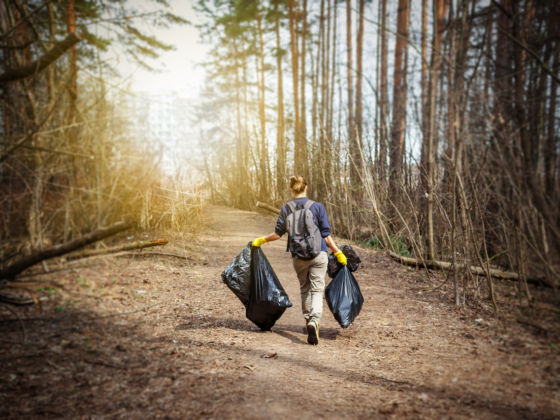WHAT HAPPENS TO THE TRASH you leave at the curb after it’s picked up? A lot. First, it’s transported to a dump or landfill site by fleets of low-efficiency garbage trucks. Then, once it arrives at its final resting place, it’s mixed into a slurry with thousands of tons of waste from your fellow citizens, where it sits — not biodegrading but rather stewing, festering, releasing large amounts of the potent greenhouse gas methane and potentially contaminating nearby soil and groundwater.
The issue of waste in America is a pivotal one, connected to so many of the major environmental concerns of our time: air and water pollution, marine contamination, global warming. That’s why companies like Subaru are working so hard to address it; Subaru is the nation’s first zero-landfill automaker and is now partnering with the National Park Service to guide our most cherished public lands towards this same goal.
But what can one person — you — do in the face of such monumental challenges? Quite a bit, it turns out. Pretty much every decision you make during the day either increases or decreases your landfill footprint. Make the right ones and that footprint starts to shrink significantly. And in a lot of instances, you might be surprised just how easy the right decisions are. Here are 14 great examples.
1. Downsize your trashcans (and upsize your recyling).
So much of successfully changing your habits depends on proper preparation — putting in place the framework that supports those habits so they become mindless, second nature. If you have less space to stuff that trash into, you’re going to naturally start recycling more — or even acting in ways that generate less trash (see below) — simply out of convenience. A great example: If your city uses official trash receptacles, opt for the smallest size they offer. Not only will you accrue the benefits of a small-can mindset, but you’ll be leading by example in your neighborhood.
2. Switch to electronic bills, cards, and invitations.
Some calculations claim that if just 5% of households switched to electronic bills and statements, we would save over 450,000 trees a year. The organization PayItGreen even has an online calculator that allows you to estimate your household paper “footprint.” You can do the same with your outgoing mail as well. Instead of buying a Hallmark card or sending invitations by mail, consider sending e-cards and e-vites to save paper.
3. Wean yourself off the plastic grocery bags.
The plastic bags we use to weigh produce and carry our groceries have a significant negative impact on our environment. Around the world, 160,000 plastic bags are used every second, and each bag can take 1,000 years to biodegrade. Avoid individually packaged produce, bring small cloth bags to collect and weigh your fruits and veggies, and most definitely keep a cache of reusable bags in the car to transport your groceries from store to home.
4. Ditch the paper towels and use an old t-shirt instead.
According to the Paperless Project, the US uses more than 13 billion pounds of paper towels each year. To put this number in perspective, if every household in the country used just one fewer 70-sheet roll of paper towels annually, we would save over 544,000 trees. Many times, we waste paper towels cleaning up water spills or other small messes that could easily be dealt with using old towels and t-shirts as rags. Whenever possible, toss old clothing into the mop bucket instead of the trash, and use them to clean the house and save paper at the same time.
5. Avoid products with excessive packaging.
Food packaging accounts for two-thirds of total packaging waste in the United States. This waste often goes straight to the landfill. To help send a message that this isn’t okay, don’t buy packaged fruits, vegetables, or other products that don’t need to be individually wrapped. Instead, buy from companies taking steps to reduce packaging in all their products or go straight to the source at farmers markets and local co-ops. Oh, and it might be time to kick that bottled water habit.
6. Recycle your electronics.
The EPA estimates that US citizens throw out around two million tons of e-waste each year. Recycling a million cell phones recovers around 35,000 pounds of copper, 772 pounds of silver, 75 pounds of gold, and 33 pounds of palladium. If your electronics are completely broken and beyond repair, instead of tossing them out with the trash, visit the EPA website to find a place near you that accepts and recycles electronic waste.
7. Ask for the takeout box…
Turns out, eating leftovers can be quite an environmental statement. The Food and Agriculture Organization estimates that almost half of all food in the United States goes to waste. Across the world, that number is around a third. Even worse, according to the EPA, more than 97% of that food waste ultimately ends up in landfills.
8. …or better yet, bring your own takeout container…
Takeout containers are usually made of paper, plastic, polystyrene foam, or other materials that we could be using less of. Then add the plastic bag used to carry the food back home, and the environmental impact gets even worse. Whenever possible, bring your own container and bag for takeout, and also your own thermos for beverages. This applies to coffee too. It’s estimated that Americans throw away 25 billion coffee cups each year.
9. …or reuse the containers you already have.
Instead of buying more containers, reuse those you already have to store leftovers again and again: jelly jars, yogurt cartons, the box you got when you ordered your pho to-go last week. A quick tip, however: Since some of these containers are made of plastics that can be harmful when used over long periods, check the number on the bottom to make sure it’s safe for reuse.
10. Print/copy double-sided.
Printers at home and in the office often have single-sided printing set as the default. Change this to double-sided, and you’ll see how few times single-sided is actually necessary (and, of course, you’ll save paper). Reducing the size of your page margins is another easy action that ends up saving more paper than you may think, particularly when printing or copying long documents like applications, college readings, etc. And don’t forget — you can recycle all this paper, reducing your footprint even more.
11. Buy in bulk.
If you know you’ll need never-ending supplies of certain foods (pasta, rice, cereal, etc.), buy in bulk whenever you can. Buying one big bag of rice creates far less packaging waste than buying several smaller bags over the course of the year.
12. Choose products packed in paper, instead of plastic.
Cardboard and other paper products are far easier to recycle than plastic. When available, buy products like laundry detergent or pasta in paper boxes instead of plastic bags and bottles.
13. Don’t ask for straws with your drinks.
We throw away enough plastic each year to circle the Earth four times. And items like plastic drinking straws (deceptively small, so easy to ignore) account for a significant portion of our plastic waste. Tell your waiter or the drive-thru attendant that there’s no need to include a straw with your drink. And if the idea of drinking without a straw grosses you out, you can always purchase a reusable stainless steel or glass drinking straw to use instead.
14. Clean green.
It’s astonishing how many types of cleaners there are — tile cleaner, toilet cleaner, window cleaner, etc. The problem? They’re expensive, they contain cocktails of some serious chemicals, and each one you buy means that much more plastic packaging waste. Alternatively, you can use simple household products like baking soda + vinegar to clean many elements of your home just as effectively. Research online to figure out how to create your own homemade cleansers. Not only does this save you money and cut down on waste, it also keeps the toxic chemicals often found in cleaning products out of your home.

